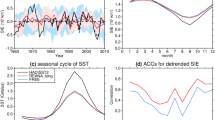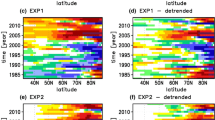Abstract
Arctic sea ice plays an important role in the climate system, moderating the exchange of energy and moisture between the ocean and the atmosphere. An emerging area of research investigates how changes, particularly declines, in sea ice extent (SIE) impact climate in regions local to and remote from the Arctic. Therefore, both observations and model estimates of sea ice become important. This study investigates the skill of sea ice predictions from models participating in the North American Multi-Model Ensemble (NMME) project. Three of the models in this project provide sea-ice predictions. The ensemble average of these models is used to determine seasonal climate impacts on surface air temperature (SAT) and sea level pressure (SLP) in remote regions such as the mid-latitudes. It is found that declines in fall SIE are associated with cold temperatures in the mid-latitudes and pressure patterns across the Arctic and mid-latitudes similar to the negative phase of the Arctic Oscillation (AO). These findings are consistent with other studies that have investigated the relationship between declines in SIE and mid-latitude weather and climate. In an attempt to include additional NMME models for sea-ice predictions, a proxy for SIE is used to estimate ice extent in the remaining models, using sea surface temperature (SST). It is found that SST is a reasonable proxy for SIE estimation when compared to model SIE forecasts and observations. The proxy sea-ice estimates also show similar relationships to mid-latitude temperature and pressure as the actual sea-ice predictions.







Similar content being viewed by others
References
Becker E, Van den Dool HM, Zhang Q (2014) Predictability and forecast skill in NMME. J Clim 27:5891–5906. https://doi.org/10.1175/JCLI-D-13-00597.1
Cohen J, Screen JA, Furtado JC, Barlow M, Whittleston D, Coumou D, Francis J, Dethloff K, Entekhabi D, Overland J, Jones J (2014) Recent Arctic amplification and extreme mid-latitude weather. Nat Geosci 7:627–637. https://doi.org/10.1038/ngeo2234
Delworth TL, Broccoli AJ, Rosati A, Stouffer RJ, Balaji V, Beesley JA, Cooke WF et al (2006) GFDL’s CM2 global coupled climate models. Part I: formulation and simulation characteristics. J Clim 19:643–674
Deser C, Tomas RA, Sun L (2015) The role of ocean–atmosphere coupling in the zonal-mean atmospheric response to Arctic sea ice loss. J Clim 28:2168–2186
DeWitt DG (2005) Retrospective forecasts of interannual sea surface temperature anomalies from 1982 to present using a directly coupled atmosphere-ocean general circulation model. Month Weather Rev 133:2972–2995
Ding Q, Schweiger A, L’Heureux M, Battisti DS, Johnson NC, Wigglesworth EB, Zhang Q, Harnos K, Eastman R, Steig EJ (2017) Influence of the recent high-latitude atmospheric circulation change on summertime Arctic sea ice. Nat Clim Change 7:289–295. https://doi.org/10.1038/NCLIMATE3241
Fetterer F, Knowles K, Meier K, Savoie M (2016) Sea ice index, Version 2. NSIDC: national snow and ice data Center Boulder, Colorado USA: updated daily. https://doi.org/10.7265/N5736NV7
Francis JA, Chan W, Leathers DJ, Miller JR, Veron DE (2009) Winter Northern Hemisphere weather patterns remember summer Arctic sea-ice extent. Geophys Res Lett 36:L07503. https://doi.org/10.1029/2009GL037274
Kanamitsu M, Ebisuzaki W, Woollen J, Yang S-K (2002) Ncep-doe amip-ii reanalysis (r-2). Bull Am Meteor Soc 83:1631
Kirtman BP, Min D (2009) Multimodel ensemble ENSO prediction with CCSM and CFS. Mon Weather Rev 137:2908–2930
Kirtman BP, Min D, Infanti JM, Kinter JL, Paolino DA, Zhang Q, Van Den Dool HM et al (2014) The North American multimodel ensemble: phase-1 seasonal-to-interannual prediction; phase-2 toward developing intraseasonal prediction. Bull Am Meteor Soc 95:585–601
Liu J, Curry JA, Wang H, Song M, Horton RM (2012) Impact of declining Arctic sea ice on winter snowfall. Proceedings of the National Academy of Sciences 109: 4074–4079
McCusker KE, Fyfe JC, Sigmond M (2016) Twenty-five winters of unexpected Eurasian cooling unlikely due to Arctic sea-ice loss. Nat Geosci 9:838–842
Merryfield WJ, Lee W-S, Wang W, Chen M, Kumar A (2013) Multi-system seasonal predictions of Arctic sea ice. Geophys Res Lett 40:1551–1556
Notz D (2014) Sea-ice extent and its trend provide limited metrics of model performance. Cryosphere 8:229–243. https://doi.org/10.5194/tc-8-229-2014
Peings Y, Magnusdottir G (2014) Response of the wintertime Northern Hemisphere atmospheric circulation to current and projected Arctic sea ice decline: a numerical study with CAM5. J Clim 27:244–264
Saha S, Nadiga S, Thiaw C, Wang J, Wang W, Zhang Q, Van den Dool HM, Pan HL, Moorthi S, Behringer D, Stokes D (2006) The NCEP climate forecast system. J Clim 19:3483–3517
Saha S, Moorthi S, Pan HL, Wu X, Wang J, Nadiga S, Tripp P, Kistler R, Woollen J, Behringer D, Liu H (2010) The NCEP climate forecast system reanalysis. Bull Am Meteor Soc 91:1015
Sarnthein M, Pflaumann U, Weinelt M (2003) Past extent of sea ice in the northern North Atlantic inferred from foraminiferal paleotemperature estimates. Paleoceanography 18:1047. https://doi.org/10.1029/2002PA000771 2.
Screen JA, Deser C, Sun L (2015) Reduced risk of North American cold extremes due to continued Arctic sea ice loss. Bull Am Meteor Soc 96:1489–1503
Serreze MC, Francis JA (2006) The Arctic amplification debate. Clim Change 76:241–264
Serreze MC, Stroeve J (2015) Arctic sea ice trends, variability and implications for seasonal ice forecasting. Phil Trans R Soc A 373:20140159. https://doi.org/10.1098/rsta.2014.0159
Sigmond M, Fyfe JC, Flato GM, Kharin VV, Merryfield WJ (2013) Seasonal forecast skill of Arctic sea ice area in a dynamical forecast system. Geophys Res Lett 40:529–534
Sun L, Perlwitz J, Hoerling M (2016) What caused the recent “Warm Arctic, Cold Continents” trend pattern in winter temperatures? Geophys Res Lett 43:5345–5352. https://doi.org/10.1002/2016GL069024
Titchner HA, Rayner NA (2014) The Met Office Hadley Centre sea ice and sea surface temperature data set, version 2: 1. Sea ice concentrations. J Geophys Res Atmos 119:2864–2889. https://doi.org/10.1002/2013JD020316
Vecchi GA, Delworth T, Gudgel R, Kapnick S, Rosati A, Wittenberg AT, Zeng F et al (2014) On the seasonal forecasting of regional tropical cyclone activity. J Clim 27:7994–8016
Vernieres G, Keppenne C, Rienecker MM, Jacob J, Kovach R (2012) The GEOS-iODAS, description and evaluation. NASA Technical Report Series on Global Modeling and Data Assimilation 30. NASA/TM–2012–104606
Wang W, Chen M, Kumar A (2013) Seasonal prediction of Arctic sea ice extent from a coupled dynamical forecast system. Mon Weather Rev 141:1375–1394
Zhang S, Harrison MJ, Rosati A, Wittenberg A (2007) System design and evaluation of coupled ensemble data assimilation for global oceanic climate studies. Mon Weather Rev 135:3541–3564
Acknowledgements
We acknowledge the agencies that support the NMME system, and we thank the climate modeling groups (Environment Canada, NASA, NCAR, NOAA/GFDL, NOAA/NCEP, and University of Miami) for producing and making available their model output. NOAA/NCEP, NOAA/CTB, and NOAA/CPO jointly provided coordinating support and led development of the NMME system. Support was provided by the National Science Foundation (AGS-1338427), National Aeronautics and Space Administration (NNX14AM19G), the National Oceanic and Atmospheric Administration (NA14OAR4310160). The views expressed herein are those of the authors and do not necessarily reflect the views of these agencies. We also thank Kristin Harnos for her guidance processing NOAA/GFDL sea ice outputs on its native grid. Comments from Dr. S. Wang and two anonymous reviewers helped to improve a previous version of this manuscript.
Author information
Authors and Affiliations
Corresponding author
Additional information
This paper is a contribution to the special collection on the North American Multi-Model Ensemble (NMME) seasonal prediction experiment. The special collection focuses on documenting the use of the NMME system database for research ranging from predictability studies, to multi-model prediction evaluation and diagnostics, to emerging applications of climate predictability for subseasonal to seasonal predictions. This special issue is coordinated by Annarita Mariotti (NOAA), Heather Archambault (NOAA), Jin Huang (NOAA), Ben Kirtman (University of Miami) and Gabriele Villarini (University of Iowa).
Rights and permissions
About this article
Cite this article
Elders, A., Pegion, K. Diagnosing sea ice from the north american multi model ensemble and implications on mid-latitude winter climate. Clim Dyn 53, 7237–7250 (2019). https://doi.org/10.1007/s00382-017-4049-3
Received:
Accepted:
Published:
Issue Date:
DOI: https://doi.org/10.1007/s00382-017-4049-3




